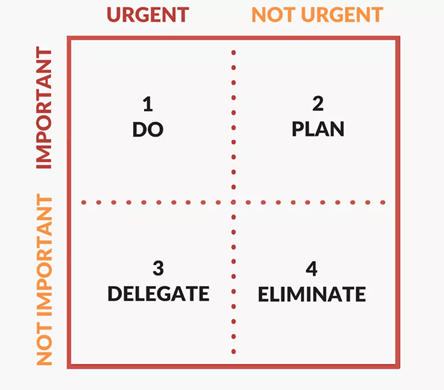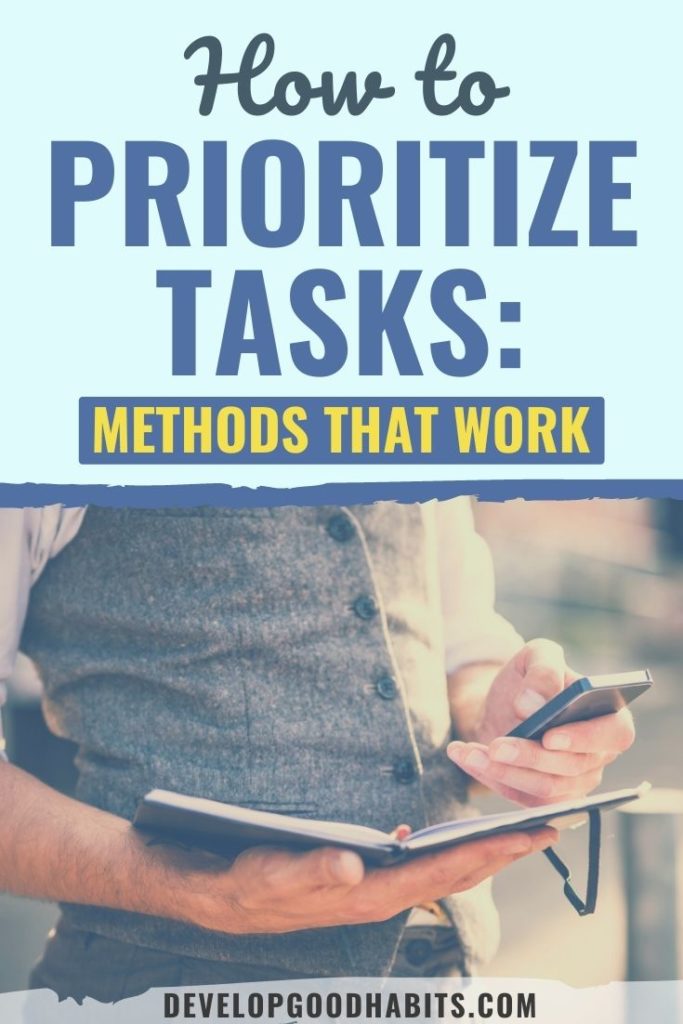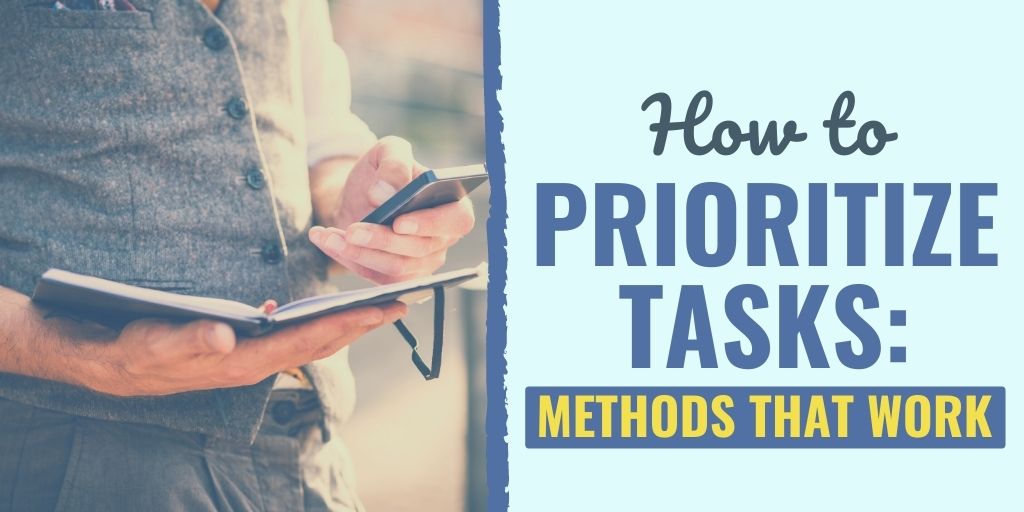There might be affiliate links on this page, which means we get a small commission of anything you buy. As an Amazon Associate we earn from qualifying purchases. Please do your own research before making any online purchase.
The worst days at work are those that are slammed busy from start to finish, but when 5:00 rolls around, you’ve hardly accomplished a thing.
I find this to be the case on days when I am constantly interrupted by phone calls, emails, and unexpected tasks. These days are frustrating because while they do require hard work and attention, I feel like I’m spinning my wheels.
This scenario used to define most of my days. Every task was urgent, and everyone’s emergencies became my emergency. But once I figured out how to effectively prioritize my time, I recognized that most of the things that I thought had to be done right away could either be put aside or even delegated to someone else. This helped me save my energy for the tasks that were actually important in the long run.
In this article, I’ll provide an overview of the different ways to prioritize the things on your “to-do” list so you can work as efficiently as possible.
We will look at five of the most popular methods for task prioritization and a step-by-step list of instructions on how to do each technique. Some of these will already be familiar from previous articles, but we will look at them in great detail so you can easily apply them to your life.
But let’s start by looking at the value of knowing how to prioritize.
What Does It Mean to Prioritize Tasks?
What does it mean to prioritize tasks? Well, I started to spend my time intentionally and in a way that would add value to the progress, I was making toward my goals. When prioritizing tasks, you need to decide which tasks should be completed and in what order to get everything done more effectively. It helps you organize your time more efficiently, which, in turn, boosts productivity.
Prioritizing involves declaring the order in which you will complete tasks based on their added value to your desired outcome. Prioritizing helps you organize your time to complete your most important task first, avoid running out of time with an upcoming deadline, and have the time you need to finish bigger projects. Knowing how to prioritize an important task can help you get more work done in less time.
Why Do You Need to Prioritize?
If you’re like most people who will read this article, you typically start each day with a genuine intention to get as much and as many of your daily tasks completed as you can.
However, before you know it, it’s noon, and rather than crossing things off of your list, you’ve added to it because of the number of urgent requests that have prevented you from taking a breath. By the time it’s 3:00 pm, you figure you will take today’s task list and write tomorrow’s date on it.
If you don't prioritize your work tasks or otherwise, you will find it harder to complete everything you need to get done. Prioritization allows you to give more focus and attention to tasks that are higher up on the list of importance, so you can push lower priority tasks down on the list.
If you don’t have a process for prioritizing your work and you’re constantly playing catch-up, you’re risking losing focus and missing deadlines. But you can turn that around and get ahead of the game by implementing some simple methods to manage your workload.
Sure, you can choose to do tasks in the order in which they land on your desk or according to the immediacy of the deadline, but this is a prime example of working harder, not smarter. You can make the most of the seemingly little time you have at work to get everything accomplished by using prioritization strategies.
Now you may be thinking: I don’t have time to finish my work; how should I be expected to take the time to analyze the amount of work I have on my plate while priorities keep on piling up? Or: I know how to make a to-do list, I’m good.
While both are valid thoughts, having a clear method in place to help you regain control and eliminate “overwhelmed” from your list of status quo feelings will let you further optimize your time and redirect your focus to only the things that matter the most.
Knowing how to prioritize your work tasks will directly impact the success of your projects, your team’s morale, and–if applicable– your leadership role. Every project you take on needs to have clear priorities.
Regardless of how well-planned your projects are, you’re sure to encounter unexpected changes or obstacles requiring you to rethink your strategy.
Whether you run a one-man show or work for a worldwide corporation, these methods to prioritize your tasks at work will help you take an objective look at the undone things in front of you and be sure where you should start. You’ll realize that a lot of the things that feel urgent…aren’t. Or, at least not yet.
Let’s look at five effective methods you can employ to take control of your work.
How to Prioritize Tasks in the Workplace
1. The “Getting Things Done” Method
Getting Things Done is a system designed by David Allen, the author of a book of this same name. In his book, Allen lays out five steps to follow to help you spend less time on busy tasks so you have more time to spend on what you actually want to do. Allen claims that his method helps people redefine how they function to create order in your world of chaos.
At its core, Getting Things Done (GTD) is a system that promises to turn your ideas and passing thoughts into actions. Once you become in tune with your system and trust the process, you can stop trying to hold onto so much information in your brain (don’t forget it’s your niece’s birthday this weekend/you have a doctor’s appointment this afternoon/buy milk on the way home), which will free up your mental energy for more valuable processes.
GTD requires you to create various lists to organize all of your priorities, so they’re manageable. This method creates a simple layout of everything on your plate so you can easily decide what to do next. You can start working efficiently when you can get all of your distractions down on paper.
To implement this method, you need to record your thoughts, goals, and plans following a 5-step workflow:
1. Capture
Write down everything that comes to mind, from responses to emails you need to send to genius ideas that you come up with at night. Write everything down in a journal or use an app to keep track of these thoughts and tasks.
Whether it’s an errand you need to run, something you notice that made you smile, or simply remembering to go for a run, record it.
Here are some examples of sub-lists you can maintain:
2. Clarify
Process everything you write down. Is it an actionable task? Is it something you can cross off your list quickly? Or is it vague?
Don't just write down “Apply for a job,” create actionable objectives for each goal so you can get to work. Clarify each of your to-dos, so it doesn’t take you longer to figure out where to start than it takes to actually complete the task.
3. Organize
Keep your lists separate and assign due dates and reminders as needed. At this point, you’re still not completing the work; you’re just getting the tasks on the right lists for later.
Make a “reference” list, a calendar, a to-do list, and even a trash pile. Also, add labels to your bullet points as you organize, marking items as “work” or “family” or some other relevant tagging system.
4. Reflect
Look over all of your lists frequently so you can make adjustments as needed. Maybe your sister called you last night, so you can cross off your task of touching base with her. Review your lists weekly to clean them up (which will therefore declutter your mind).
This review period will allow you to see where you're making progress and where you may need to readjust your priorities. If you skip this step, things will pile up, and the system will fail.
5. Engage
Now that your system is set up, it’s time to get things done. Work through the first four steps by choosing your next action and doing it. You’re now set up with an easy-to-navigate system organized by priority and categorized appropriately.
You know what you have to do and when you have to do it. You’ve created small, manageable tasks that have no barrier to start.
When using this system, keep the following tips in mind:
The goal of this method is to create some space in your life. If you spend some time organizing your schedule, you can save time in the future. Doing this will make you more relaxed and less overwhelmed because you'll never need to worry about what you should do next, where you should start, or when you'll find the time. Your GTD system will organize that all for you. This will help increase your engagement with your own life.
2. The Eisenhower Decision Matrix
The Eisenhower Decision Matrix method was originally developed by our former President and World War II veteran, Dwight Eisenhower.
When in these leadership roles, prioritizing his tasks was an imperative part of Eisenhower’s success. He invented the Eisenhower Decision Matrix principle to help prioritize tasks in order of urgency and importance.
Just because this is associated with Eisenhower doesn’t mean it’s an old-fashioned tool. Sure, it’s an older principle, but it’s survived the test of time. Stephen Covey, the author of The Seven Habits of Highly Effective People, has used Eisenhower's concept, further popularizing it in our modern-day times.
Studies show that people prioritize tasks with a deadline over all others, even if completing those tasks offers very few rewards. But when you stop to consider the consequences of your choices, you’re more likely to complete important tasks over the ones with a deadline.
This research shows that you can rise above the urge to spend your time on tasks that are really just distractions if you can keep the long-term impact of non-urgent projects in mind. This framework for prioritization helps you distinguish between important vs. urgent duties.
The Eisenhower Matrix consists of four quadrants that you use to organize your to-do list in a way that makes you consider the amount of time that you end up wasting every day. Using these practices allows you to plan ahead, avoid procrastinating, work more efficiently, and boost productivity. In turn, you will decrease stress and reduce your chances of experiencing burnout.

As you can see, the Eisenhower Matrix has four elements. Here is how they work:
Q1: Urgent and Important, Do
All of the tasks in quadrant 1 are urgent and important. These items have a clear-cut deadline and looming consequences should you not take action. No amount of pre-planning will impact how these tasks affect your schedule.
Things that fall into this box include:
Q2: Not Urgent and Important, Plan
These tasks are important, but they’re not urgent. Completing these tasks will bring you closer to meeting your goals; however, they don’t have a designated deadline. This may include things like your MITs and other critical items to your success over the long-term but don’t need to be done immediately.
Without a set deadline, people tend to procrastinate when it comes to these responsibilities. However, just because they aren’t urgent doesn’t diminish their importance in any way, so you should be intentional about completing the items in this box.
Some examples of tasks you can plan are:
Q3: Urgent and Not Important, Delegate
Things that can be delegated are tasks that do have to be completed but not necessarily by you. Think of this as “busy work” that someone who has fewer skills than you could easily complete. So this is any task that you could have an assistant do, such as:
Spending your time in quadrant three may make you feel busy, but you’re not really doing anything productive.
Q4: Not Urgent and Not Important, Delete
Your goal is to eliminate these tasks because they’re a waste of your time. These things are just distractions that ultimately make you feel like you could have made a better choice with your mental energy:
By deleting these tasks, you can free up some much-needed space for items in Q2.
This method helps you consider the long-term outcomes of how you spend your time so you can plan in a way that makes you the most effective instead of just the most productive.
When you can visualize all your to-dos in this matrix, you can easily see where everything falls on your priority list, from your smaller tasks to your bigger projects.
Your goal with the Eisenhower Matrix is to make sure you’re spending the bulk of your time in Q2. The time you spend engaging with Q2 tasks positively impacts your overall success because this is where planning and action turn into progress.
To find out where you lie on the matrix, track yourself by keeping a tally of everything you do for a few days and organizing it on the matrix. Once you have this data, sit down and analyze how much time you’re wasting and how you can better allocate this invaluable resource.
3. Eat That Frog (i.e., Do the Hardest Things First)
This method is best for people who often procrastinate on tasks that require too much effort, focus, or hard work.
Brain Tracy, author of Eat That Frog!, built this method of prioritization based on a Mark Twain quote: “If it's your job to eat a frog, it's best to do it first thing in the morning. And if it's your job to eat two frogs, it's best to eat the biggest one first.”

Tracy argues that if you can complete your hardest or most dreaded task first, you’ll start your day off with an accomplishment that will set the tone for the day. Also, knowing you’ve completed the one task that you were tempted to put off makes every other task for the day seem simple.
Here is a step-by-step guide on how to eat that frog:
1. Identify Your Frog
Similar to the important/urgent matrix we did above, create a need/want matrix with the four squares as follows:
You will find your frogs in the first box of this matrix. These are the things you need to do but don’t want to do, which is why you keep putting these tasks off.
2. Change Your Routine
If you’re like many people, the first thing you do when you get to work is check your email and voicemail. But this really doesn’t accomplish anything; it just adds list items to your already long list of tasks without completing anything that truly needs to be done.
Stop this distracting morning habit and turn your attention to more important tasks that will clear up some space for you to work.
3. Prepare Yourself
Every night, make sure you have whatever you need to eat your frog in the morning. This will reduce the amount of effort you need to put forth the next day and limit your opportunity to put this task off.
Organize yourself, so you have very few things to worry about when you wake up, and you can just get it over with. Break the task down into bite-sized chunks if needed so it feels more manageable.
4. Practice
Remember, if you do this intentionally enough times, you will start to do it subconsciously. Build your “muscle memory” by creating this habit. Once this habit of eating that frog becomes a routine, it will start to come naturally. And as soon as you see how satisfying it is to cross that big task off your list, it’ll motivate you to keep going.
If you can commit yourself to just getting started and working on your hardest task right away, you’ll discover that it is probably not as bad as you thought.
Now, you may think this isn’t complex enough to be a method for prioritizing your complicated schedule. But the truth is, you know you will be able to stick to this simple method when things in your life get stressful.
Whether you want to overcome procrastination or be more intentional about your workday, this powerful method will help you get there.
4. The ABCDE Method
This method is another that Brian Tracy introduced. This method is all about being purposeful with your time. Tracy points out that the more thought you put into designating your priorities before you get to work, the more time you will spend on the important things.
And the more valuable the task is, the more motivated you will be to power through procrastination.
The ABCDE Method is a simple and effective prioritization technique that can increase your efficiency and effectiveness. This method guides you in making your to-do list actionable and urges you to accomplish your tasks.
Let’s walk through it.
1. Make Your To-Do List
You’re going to start with your familiar to-do list. Simply write down everything that you need to accomplish today. Easy enough.
2. Mark Your “A” Items
These are the most important tasks–the things you have to do. These are your Q1s, your frogs, and your musts.
It’s ok to have more than one “A” task, just mark them as A-1, A-2, and so on. Make sure your A-1 task is the most critical task of them all.
3. “B” Tasks
These are the tasks you should do, but you will only face mild consequences if you don’t.
This could be things like returning a non-urgent message or clearing out your inbox.
You should never do a B task if you have an A task still on your list. B tasks could be considered distractions or reasons to procrastinate if you leave an A task undone.
4. “C” Tasks
While you may want to do a C task, the end results of these tasks have no impact on your progress toward your long-term goals. These tasks include grabbing lunch with a friend or seeing a new movie that just came out.
These activities don’t affect your professional life but may impact your personal well-being. Unless you’re on an official break from work, don’t perform a C task when you have a B or A task that’s undone.
5. “D” and “E” Tasks
You’re familiar with these from the previously mentioned methods. D is for Delegate, and E is for Eliminate. Delegate everything you can to other people to free up time to work on your A tasks. Eliminate your E Tasks because they’re unnecessary, and you can better use your time.
You just have to discipline yourself to complete your A1 task and then work your way down the list. You will automatically get more done when you can form the habit of spending the most energy on your A1 and avoiding doing anything not on your list.
Whenever a new task pops up, don’t react immediately by completing it immediately. Put it on your list and label it so you can work on it accordingly.
Reacting to continuous demands will cause you to lose control of your time because you will waste it on low-value activities. Practice this method to develop a habit of concentrating on the tasks that will have the greatest impact on your future.
5. Warren Buffett's 25-5 Rule
Warren Buffet is arguably the most successful investor of all time. But in addition to managing his money, he is also very skilled at managing his time.
Buffet came up with a quick exercise for prioritizing your biggest career goals that produce great results. Doing it will maximize your productivity and reduce the amount of time you waste on futile endeavors. It goes like this:
1. List Your Goals
Write down 25 things that you want to complete in the near future. This can be somewhat of a brain dump–don’t leave anything off your list. Nothing is too big or too small.

2. Prioritize
Rank the items on your list in order of importance. Highlight your five most important goals.
3. Eliminate
Cross out goals 6-25.
While you may be able to come up with 25 things that you would love to do in an ideal world, you're not going to accomplish all 25 of them…or at least not well. However, if you maintain your focus, you might be able to accomplish five things.
So what is preventing you from staying focused? Tasks 6 through 25. These are the goals you're interested in chasing, but they act as potential distractions when it comes to achieving things. These are the things that are holding you back.
You can apply this principle to your everyday schedule to help you prioritize your life on a smaller scale. Each morning, make a list of 10 things you'd like to complete. Highlight the top two and ignore the rest for now. Don't spend any time on tasks 3-10 until you’ve accomplished the first two goals on your list.
You can apply this on a weekly and monthly basis as well.
It’s critical to use this “selective focus” process when choosing how to spend your time because there are a lot of things competing for your attention at any given moment. Every time you start working toward something new, you are doing so at the expense of an opportunity cost. You’re losing the time and attention you could be spending on other things that may be more important to you.
This method makes your decision-making process easy if you’re faced with a choice of how to spend your time. If something else shows up on your desk halfway through the day, ask yourself if completing it would help you reach one of your top goals. If the answer is no, keep it off to the side.
When you're forced to eliminate some things from your day, you will quickly recognize what’s truly important to you.
Tips on How to Prioritize Tasks in the Workplace
Now that we have gone through our proven methods above for prioritizing, let's take a look at a few more tips to keep in mind to make the process of prioritizing tasks easier.
Task Management
Distractions in the workplace are normal and can't always be avoided. So, when dealing with task management for your day and week and when scheduling your time, make sure to account for these distractions. It might even help to schedule your breaks during the task management process.
Time Management
With so many advancements in technology, we are finding it easier to follow through with good time management, especially when it comes down to prioritizing tasks. You can download applications that help you keep track of the time you spend on specific tasks. This can show you how efficiently you are using your time, and you can then adjust accordingly.
The Pareto Principle in time management simply states that 80% of results will come from 20% of your effort. The Pareto Principle helps us set the right priorities, which is especially important if you face competing priorities.
The Pareto Principle helps us focus on tasks and activities that need immediate attention and will have the most significant impact on our business.
Project Management
When dealing with project management, it is best to tackle one thing at a time. While multitasking to get everything done may seem like a tempting offer, you want to avoid this.
You need to make sure your full attention is being placed on the tasks with the highest priority – an urgent task of high priority should take precedence on your task list. Get these bigger tasks done before moving on to the next thing on your list.
Final Thoughts on Methods to Prioritize Tasks at Work
So, there you have it. Five methods that you can put to the test to help you prioritize everything on your to-do list. Try each of them out to see which one works best for you.
To help you understand between, read this post about the difference between being task-oriented and goal-oriented.
Chances are, you will find yourself using at least one tip from each method in some area of your life. And while it might not seem this way at first, the more you practice eliminating tasks of little value (like you will have to do with all of these methods), the more liberated you will feel.

Connie Mathers is a professional editor and freelance writer. She holds a Bachelor's Degree in Marketing and a Master’s Degree in Social Work. When she is not writing, Connie is either spending time with her daughter and two dogs, running, or working at her full-time job as a social worker in Richmond, VA.


